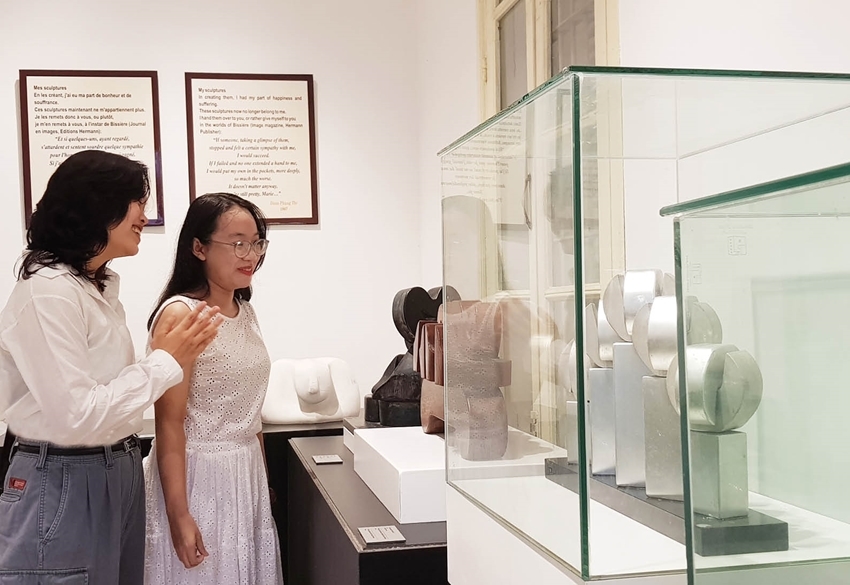 |
| Visiting artifacts on display at Hue Fine Arts Museum |
Many limitations and difficulties
Established at the end of 2018, Hue Fine Arts Museum consists of three spaces: Le Ba Dang Art Gallery (15 Le Loi), Diem Phung Thi Art Gallery (17 Le Loi, Hue City) and Fine Art Exhibition Space (no exhibition venue yet).
Up to this moment, Hue Fine Arts Museum is displaying, storing, and preserving more than 2,000 fine artworks, artifacts, and documents about fine art, including sculptures, paintings, graphics, and contemporary art (video art) with materials such as copper, stone, aluminum, plaster, ceramic, wood, carpet, fabric, paper, film, etc., in which, nearly 300 works are on display, the rest are being stored in the base warehouse.
Currently, the museum has two types of preservation warehouses. The warehouse with temperature conditions on request is equipped with dehumidifiers, temperature and humidity meters, air conditioners, and metal racks to store artwork and artifacts classified according to the material of the work, such as oil paint, paper, silk, etc. Meanwhile, the warehouse under normal temperature conditions is mainly the storage of copper, stone, ceramic, aluminum, wood artifacts.
In addition, the museum is also applying two modes of regular and periodic preservation. Preservation of works and artifacts is always carried out in a scientific and reasonable manner, in accordance with regulations on the preservation of museum artifacts. The preservation process goes through steps such as observing, researching, analyzing, and evaluating the current status and causes of damage to the object; then, checking and performing the necessary tests; formulating plans and procedures for preserving artifacts and making plans for implementation; preserving and repairing artifacts according to approved plans and procedures.
However, according to Ms. Dinh Thi Hoai Trai, Director of Hue Fine Arts Museum, the museum's warehouse is currently facing many limitations and difficulties, not meeting the requirements of the archiving of artworks according to the regulations.
The total area of the museum's warehouse is more than 100m2, but it must store more than 1,500 documents, works, and artifacts. This makes it difficult to classify and arrange each warehouse by material and type to ensure storage conditions in terms of temperature, and humidity, as well as suitable shelving facilities for the arrangement of works scientifically.
Need of methodical preservation system
With the space to display artworks, the air conditioning system, dehumidifier, and art lighting system have not yet been invested in accordance with standards. There is a lack of technical equipment such as light meters, UV radiation meters, etc. Therefore, the works displayed here are "under pressure" with the fear of being damaged or degraded over time.
“Hue humidity is quite high, which is an ideal condition for mold growth. This makes the exhibits on display, which have materials that are easily damaged by harmful agents such as textiles, paper, oil paintings, etc., quickly damaged and difficult to handle," said Ms. Trai.
Faced with those concerns, the head of the Hue Fine Arts Museum said that it is necessary to have a budget to invest in a system of warehouses to store and preserve artifacts and to renovate and expand the warehouse area that fully satisfies the conditions and requirements for preservation for each type of material, artifacts, images, and documents. The lighting system for exhibits, radiation meters, photogrammetry, and shelves also need to be upgraded.
According to Ms. Trai, in the future, it is necessary to perfect the organization of the preservation warehouses in a scientific manner in the direction of open warehouses, in order to both ensure the safety of the artifacts and to serve the research and lookup of artifacts quickly and conveniently. Notably, it is necessary to plan the movement of artifacts in order, give a plan and diagram to move artifacts when there is fire, explosion, or natural disaster to ensure the highest safety for the work as well as to control security and safety for exhibits, to ensure that they are not stolen.
"In particular, the management and professional staff of the museum is the most important factor in resources, playing a decisive role in the development of each museum," said Ms. Trai. Therefore, the museum focuses on investing in professional training through training courses on museum operations, including the domestic and international preservation of artifacts.